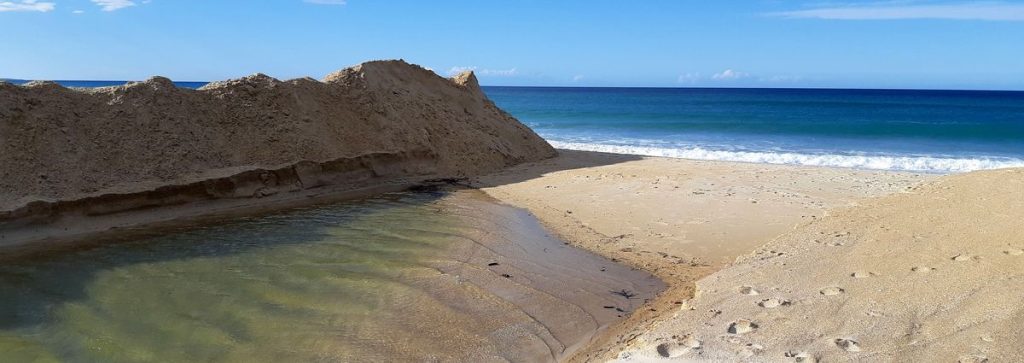Current Projects and Activities
- Break O’Day Aquatic Facility Feasibility Analysis
- St Marys Early Childhood Needs Analysis
- St Helens General Cemetery Master Plan
- Scamander Coastal Hazards and Flood Risk Adaptation Pathways Project
- Scamander- Beaumaris Structure Plan
- Bay of Fires Master Plan
- Strategic Land Use Project - Industrial Land Use Study
BRIEF PROJECT DESCRIPTION:
The Break O’Day Council is exploring the potential construction and operation of an Aquatic Facility in our area. The project initially involves a feasibility analysis to assess whether such a facility is viable. This analysis will examine the various components of the proposed aquatic facility, including its design, potential locations, and the anticipated level of community use. Additionally, the financial projections will be broad and consider the community’s ability to fund the project. The primary goal of the feasibility analysis is to address key questions, such as whether an aquatic facility is feasible, what it could look like, where it might be located, and how it would be financed.
Break O’Day Aquatic Facility Feasibility Study Final Reports
We are pleased to provide you with the finalised Aquatic Centre Feasibility Study Report from Otium Planning Group. This Report has been developed from extensive work by Otium, Council officers and Council’s Aquatic Facility Working Group. A big thank you to everyone involved for the work which has been completed.
As an introduction we have prepared a short explainer video which introduces the project and covers the key findings:
Click below to view the full report:
BOD Aquatic Feasibility Report
To help break down what the Feasibility Study means for our community, we’ve also prepared the following supporting documents and resources:
Frequently Asked Questions (FAQ) Sheet
Community Focused Executive Summary (November 2025)
Economic & Social Benefits Assessment (August 2025)
“Can We Afford It?” Financial Assessment (November 2025)
COMMUNITY SURVEY NOW OPEN
We’re also seeking your feedback through a new community survey. After reading the information, please take a few minutes to complete the survey and share your views on this project.
https://www.surveymonkey.com/r/GMBMD7M
No final decision has been made about whether to proceed with an Aquatic Facility. Understanding the facts is important before Council considers next steps, including whether to develop a detailed business case.
We appreciate you taking the time in reviewing the information and encourage everyone to stay informed as the project progresses.
Thank you for taking the time to find out more about this project. It has taken longer than we originally envisaged and we apologise for this, but that has been about us making sure all of the information is available to the community to have a complete understanding about the project and what it means
CONSULTANTS:
Otium Planning Group
KEY ACTIVITIES & INDICATIVE TIMELINES:
| DATE | ACTIVITY | DETAIL |
| August-September 2024 | Pre-Research | Reviewing all background studies, demographics etc. Reviewing competitor facilities and aquatic trends. This will inform a Needs gap analysis |
| Late October – Early December | Community Engagement | This will include:
|
| November | Research comparable facilities | Examining three rural or similar facilities |
| January 2025 | Component Schedule | Outlining what the facility would require to help guide site capability discussions |
| Cost Plan | Based on agreed components, a high level cost plan will be developed | |
| Financial Monitoring | Develop a detailed financial model and investigate potential funding opportunities | |
| February 2025 | Draft Feasibility Study | A Draft will be presented to Council for discussion. After it has been to Council it will be released to the community for their input. |
| February – March 2025 | Community Feedback | Community feedback on the draft will be collated and considered in the final version |
| March 2025 | Final Feasibility Report | Will be released to the public and uploaded to Council’s website. |
* It is important to note that the Key Activities and Timelines are indicative only and that they may evolve and change as the consultancy progresses.
COMMUNITY ENGAGEMENT OPPORTUNITIES:
There will be several opportunities for the community to have their say on the Aquatic Feasibility Study project. We will share links and promotions to these opportunities here as they arise. We will also promote these opportunities through our Newsletter, Social Media and email databases as well as other local media outlets.
COMMUNITY FACE-TO-FACE WORKSHOPS
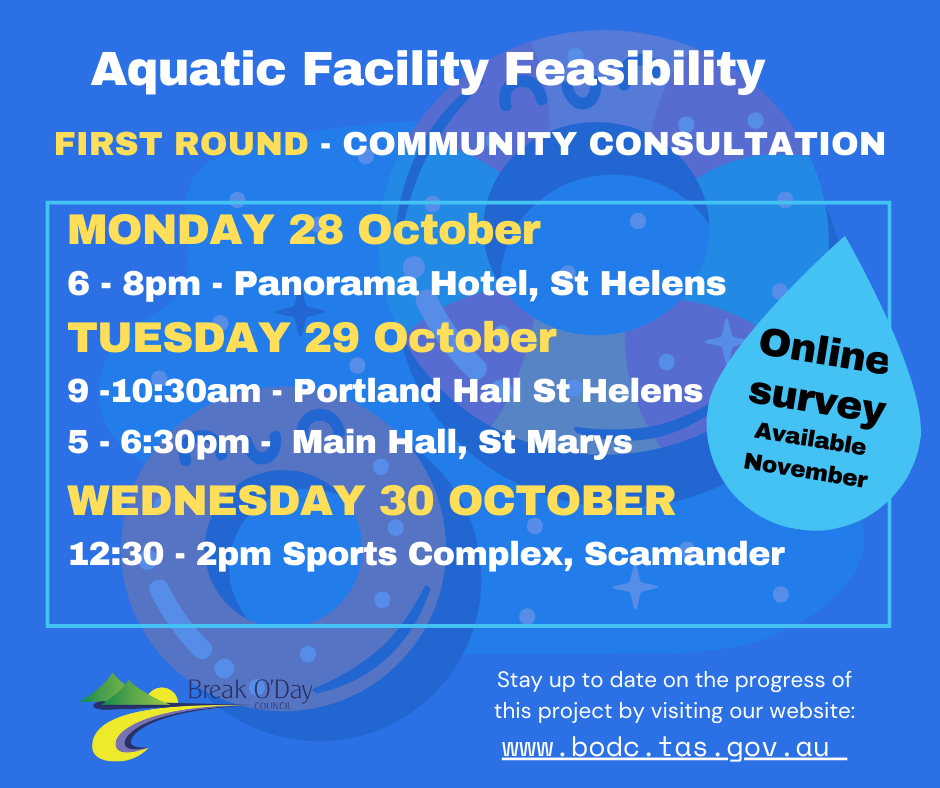
WHAT HAPPENS TO THE REPORT
Once the Feasibility Analysis has been developed, it will be presented to the Council who will decide if the project investigation should proceed to Stage 2 which is the development of a detailed business case and concept design.
The investigations and ultimately decision making around a potential Aquatic Facility in the area will be the most complex and ultimately future shaping project to be considered by the Council since the amalgamation of Portland and Fingal Councils creating Break O’Day in 1993. A decision to build and manage an Aquatic Facility will be lived with for future generations.
Once this work is completed, Council will need to make a decision on whether to progress to Stage 2, you can find the various stages of this project in the Methodology document below.
If progressed, the construction of a facility will require external funding, meaning Council will need to seek State and Federal funding to deliver such a project.
INTRODUCTION:
Break O’Day Council, in partnership with the Eastern Strategic Regional Partnership and with support from the Tasmanian Government, is leading a comprehensive Childcare Needs Analysis for St Marys and Tasmania’s East Coast. To deliver this important work, we have engaged Ninety Mile Consulting (NMC), who bring strong experience in regional early childhood planning.
This project will help us better understand the current and future needs for early childhood education and care (ECEC) and outside school hours care (OSHC) across our communities. The aim is to identify sustainable service models, potential sites for new or expanded services, and workforce strategies that improve the availability and accessibility of childcare for families across the East Coast.
Council recognises that strengthening early years services requires genuine collaboration. This project reflects local and state governments working together, supported by expert consultancy, to build a clearer picture of what our region needs now and into the future.
Across Tasmania’s East Coast, families are navigating long travel distances, seasonal work patterns, and limited childcare availability — challenges that are common across regional Australia but often more pronounced in smaller communities like St Marys. Understanding these local realities is essential to planning services that are stable, accessible and fit-for-purpose.
Through local engagement, demographic analysis, and strategic planning, this Needs Analysis will produce practical, actionable recommendations. Break O’Day Council and NMC are working closely with community members, service providers, and government partners to ensure the findings reflect lived experiences and support long-term, sustainable early years outcomes for our region.
UPCOMING EVENTS
Online Information session
Monday 24 November 2025 from 4pm
To register – contact: matt@ninetymileconsulting.com
SUPPORTING DOCUMENTS:
St Marys & East Coast Tasmania ECEC & OSHC Needs Analysis Compressed
Summary Document Tasmania East Coast ECEC & OSHC Needs Analysis – Break O’Day Council
INTRODUCTION
The St Helens General Cemetery is entering a new chapter with the commencement of Stage 1 of the Cemetery Master Plan—the creation of a Remembrance Garden. This work forms part of Break O’Day Council’s long-term commitment to enhancing local cemeteries, creating peaceful spaces that support reflection, remembrance, and community connection.
PROJECT DETAIL
In 2014, Break O’Day Council collaborated with Lange Design and the community to develop master plans for the cemeteries in St Helens, St Marys, Fingal, and Mathinna. These plans aimed to transform the sites into more serene, garden-like spaces that are welcoming, respectful, and comforting for families and visitors.
The first stage of the St Helens General Cemetery Plan will see the construction of a Remembrance Garden—a quiet and calming space designed for contemplation and tribute. This is a significant and sensitive project that honours the wishes of the community and reflects Council’s commitment to respectful public spaces.
TIMELINE:
Start Mid-August 2025 (weather permitting)– expected 8 weeks to complete
Disruption: Minimal to none; the cemetery will remain accessible to visitors throughout the works
STRATEGIC ALIGNMENT
This project aligns with several objectives outlined in the Break O’Day Council Strategic Plan, including:
Community – Foster a supportive and welcoming community.
The Remembrance Garden provides a peaceful, inclusive space for all community members to remember loved ones.
Environment – Promote and enhance our natural and built environment.
The garden will enhance the cemetery’s landscape, supporting biodiversity and improving amenity.
Infrastructure – Maintain and improve local infrastructure and facilities.
This project improves the functionality and experience of a key community space.
Project Budget
The Stage 1 works, including landscaping and garden development, have been budgeted as part of Council’s current capital works program.
Cost for Stage 1 Remembrance Garden: $50,000
Click the links below to view the design concept plans:

LATEST NEWS
1. Hazard Adaptation Planning Workshops, 28 October
Nearly 20 people attended these workshops with discussion and ideas shared to help plan future coastal and flood hazard management and adaptation for different parts of the Scamander River Mouth.
The workshops looked at hazards affecting key sites at the River Mouth: Dune Street, Pelican Sands, Northern estuary (lagoon/backwater), Bridge Esplanade, and Upper Scamander Road.

You can download the workshop presentation slides available HERE.
For each key site scenarios of interventions and measures to take over time are described. Generally starting with some erosion and inundation control and accommodation actions, and in the distant future, contemplating retreat in some places.
Whether you made it to one of the workshops or not you can use the questionnaire below to comment further on the measures proposed, when they might be ‘triggered’ and what would be needed for them, for each key site. And you can use this information to think about your own risk management and future steps.
Your input will be used to evaluate adaptation pathways options, their costs and benefits and the best sequence of steps to take and when. The project will then prepare an overall Adaptation Pathways Plan.
2. Share your thoughts – online questionnaires
Use this second questionnaire to check on the coastal and flood hazards at the River Mouth and the assets and values they may impact, and provide input on measures and interventions to manage them with long term adaptation pathways.

We have put two lots of questions into a second online questionnaire.
- What have you noticed in the Outlook report (see below) for coastal and flood hazards and the assets, services and values identified at the September workshop?
- From the October workshops, what do you think of the key sites and scenarios of measures and pathways proposed for them?
Access the questionnaire HERE
PROJECT DESCRIPTION
The Scamander Coastal Hazards Project focuses on the increased risks of coastal erosion and inundation at the Scamander River Mouth, especially during extreme weather events when high seas, heavy rain and river floodwaters combine.
The project aims to increase understanding of complex coastal and flood processes at the Scamander River Mouth and reduce risks to properties, infrastructure and the environment from the hazards they pose. Through it the community, stakeholders and Council will gain insight into the dynamics of this natural system and the implications for them when climate change makes the future at the River Mouth uncertain. Government agencies and other stakeholders are being involved in the project as the coastal and flood risks threaten public infrastructure and services, natural values and recreation.
The project will develop and evaluate options for risk mitigation and adaptation actions and a plan ‘adaption pathways’ for managing the coastal hazards and risks related to stormy seas, flooding and sea level rise due to climate change. It includes undertaking limited mitigation works to reduce immediate risks at the River Mouth.

COASTAL AND FLOOD HAZARDS AT THE RIVER MOUTH
The Outlook report – Scamander Coastal Hazards & Flood Risks reviews coastal and river processes, the hazards they pose, implications of climate change and management practices. It also looks at existing assessments and mapping of the hazard risks and their limitations for management of the risk and adaptation planning at the river mouth. The following is a summary, or read the full report HERE.
Natural Processes
River Mouth Dynamics: The Scamander River is an ICOLL (intermittently closed and open lake/lagoon) system, with a sand berm periodically closing the mouth. The entrance migrates naturally along the coast.
Wind, Tides, Waves: Seasonal wind patterns, microtidal conditions, and exposure to Tasman Sea storms influence sediment transport, berm formation, and coastal erosion.
River: The Scamander catchment produces significant flood events that can develop rapidly. High river flows rise to breach the berm when it is closed and reshape the mouth channels.
Sediment Transport: Beach sand is regularly reworked on the coastline, with episodes of both northward and southward longshore drift occurring. Sand comes and goes in the mouth forming shoals (extending to under the bridge), meandering of channels and the beach berm.
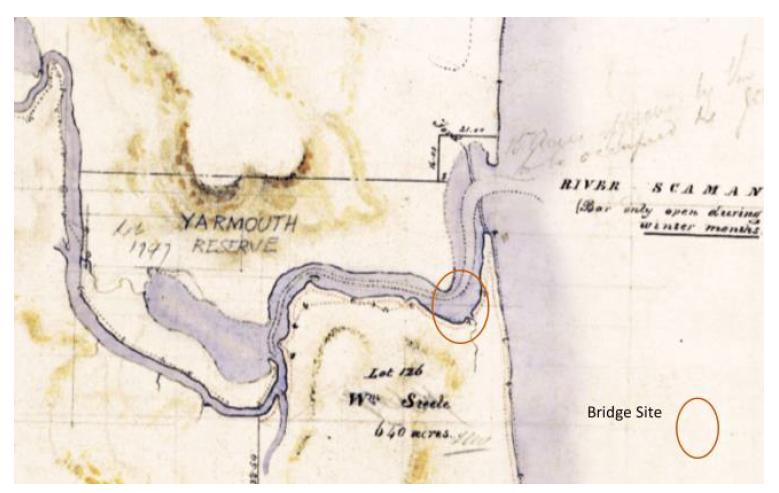
River Mouth History: Records show the Scamander River entrance has migrated up and down the coastline over time, typically 500m, but up to a 1500m range. Beach shorelines have also moved. Human activity has affected the mouth, such as the old training wall which restricted southward entrance migration from the 1990s, until about 2015.Climate Change: These natural processes are expected to intensify—raising the beach berm, increasing flood inundation, accelerating shoreline retreat, and shifting the river mouth inland.
Hazards
Coastal Erosion: Short-term and long-term erosion affects beaches and estuary banks, driven by waves, tides, and sea level rise.
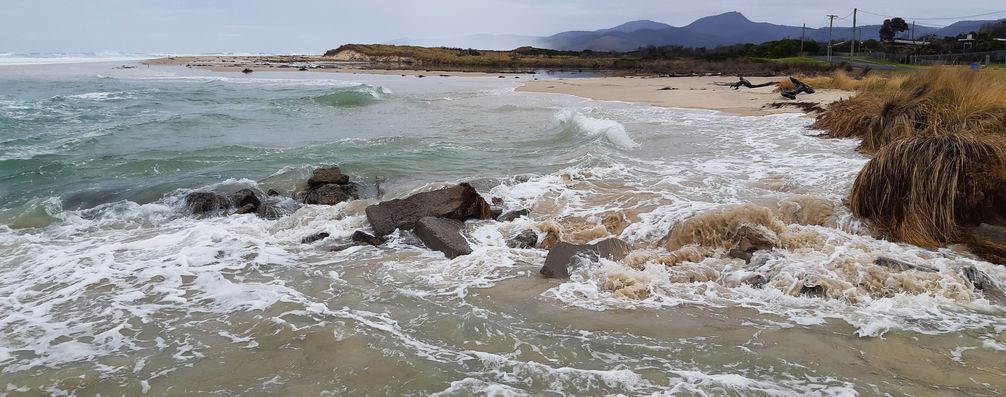
Estuary Foreshore Erosion: Varies with entrance conditions; some areas protected by revetments, others exposed.
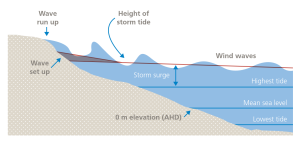 Coastal Inundation: Caused by high tides (sea level), storm surge and wave runup and is worst when they occur together.
Coastal Inundation: Caused by high tides (sea level), storm surge and wave runup and is worst when they occur together.
River Flooding: Produced by rainfall in the river catchment heavy enough to spill over the banks of watercourses. The barway being closed or open significantly affects inundation levels and roads and property are impacted by floods.
Coincident Events: Hazard impacts amplify when coastal and flood hazards coincide – such as in March 2021. It is difficult to assess the likelihood of coincidence and the increased compound risks.
Implications of Climate Change: Increased rainfall intensity, stronger coastal storms and sea-level rise (0.92m by 2100) are projected to exacerbate river flooding and coastal erosion and inundation. Soft shorelines could retreat 10m of for every 0.2 m sea level rise and the River’s ICOLL features and process would be unsettled.
Hazard Assessments
Existing Studies and Mapping: Tasmanian studies to evaluate and map coastal erosion and inundation and river flood risks have produced useful assessments for long term adaptation planning for Scamander and are they applied by Tasmanian Planning Provisions. In reviewing the studies for the River mouth several limitations have been identified.
Coastal Erosion: Didn’t account for wave runup, barway-berm dynamics and entrance migration. Risks at Dune Street in particular are underestimated, which was threatened by erosion in recent years [late 2022] when the mouth channel moved close to the Street.

Coastal Inundation: Underestimates risk by not including wave setup and runup (which are affected by the barway being open/closed) and interaction with river floods.
River Flooding: The Tasmanian Strategic Flood Mapping project provides the best available data for the river mouth. However it doesn’t account for the interaction of sea storm surge and waves with flood waters, or the state of the barway and when it is closed the height of beach berm.
Management History & Practices
Training Wall (early 1990s-2015): Initially effective but now failed due to storm damage and no longer controlling entrance channels.
Bridge Abutments: Still effective in controlling scour since bridge construction (1991).
Foreshore Protection: Rock revetment have been placed on northern and southern foreshores. Rock revetment placed in the early 1990s to protect the south bank adjacent to the park has been effective but is starting to degrade now. On the north bank (Pelican Sands) rock works 20-30 years ago have been collapsing progressively. Some informal protection has been applied more recently.
Entrance Opening: Council manually opens the barway if closed, inundation levels rise and/or heavy rain is forecast—success varies with the dynamics of the river mouth and its coastal processes.
Local Mitigation: The Scamander Surf Life Saving Club has applied mitigation and adaptation measures for it’s club building after inundation and storm wave impact.
Some recommendations
- Use existing hazard assessments and mapping of risks, but for all hazards consider underestimation, due to coastal storm factors not being accounted for.
- In the Dune Street area, apply erosion risk buffers (hazard bands) from the shoreline around 2022, when the entrance channel migrated south.
- Improve hazard assessments and models to include barway/berm dynamics, entrance status, and coincident events compounding risks.
———————————————————————————————————————————————
‘ICOLLs’
Scamander estuary and river mouth is a member of the Intermittently Closed and Open Coastal Lakes and Lagoons (ICOLLs) that many communities on Australia’s east coast live by and know well. The NSW Department of Planning, Industry & Environment has produced an information guide that provides “technical background to the factors controlling entrance dynamics of intermittently closed and open lakes and lagoons (ICOLLs), how entrance dynamics affect water quality and ecology, and the likely consequences of different management interventions. “
This ICOLLs information guide is a useful resource for understanding the dynamics of the Scamander River Mouth and its barway.

NSW and Department of Planning, Industry and Environment 2021 – ICOLLs webpage
CONSULTANTS
Working with Council and you are SGS Economics and Planning (sgsep.com.au), the lead consultant who are applying a ‘coastal adaptation pathways approach’ they have previously applied in Break O’Day around Georges Bay. Moffatt & Nichol (www.moffattnichol.com) is providing coastal and marine specialist expertise.
HOW PARTICIPATE
Keep in touch with the project
Return here to keep up to date and get news and updates by email.
If you’re not on the project email contact list already you can register an address with the last question in the questionnaires. (You are on the list already if you received the first project email recently, inviting you to share what you know with the questionnaire.). Or call or drop in at our office in St Helens.
Come to project workshops
There is a project calendar below with future workshop activities. Final dates and times will be confirmed as the project progresses.
Share your comments and ideas with the project
We’ll have more online questionnaires for you to provide input through the next analysis and evaluation stages of the project.
PROJECT CALENDAR
| Date | Activity | Detail |
| 15 June 2025 | Invitation to a community coastal and flood hazards information activity and sharing local knowledge. | Targeted at stakeholders and impacted property owners – direct contact and community information session. |
| 23 – 24 June | Consultants in Scamander gathering information. | Site visits, meet with community members and stakeholders |
| 24 June | Community information session, Scamander Sports Complex 5pm | Coastal processes and hazards at the River Mouth, things valued and cared about at risk and risk management ideas. |
| July-August | Opportunities for input and interim project reports. | Community and stakeholder engagement and information online – input on past, present assets/values and options for adaptation.
Project interim findings reports. |
| 3 September 5-6PM | Second workshop and engagement – interim findings and pathways development.
At Scamander Sports Complex |
River Mouth situation, what is at risk, uncertainty and prudent options. Identifying pathways for mitigation and adaptation actions for evaluation
‘No regrets’ initial mitigation works. |
| September – October | Analysis and pathways planning | Cost/benefit analysis and adaptation pathways development.
Mitigation works planning. |
| 28 October 1-3pm or 5:30-7:30pm |
Third workshop and engagement – development of possible Adaption Pathways (day and evening workshop options) | Input on strategies appreciative of the assets and values at risk and future climate change.
Identifying adaptation pathways of risk management actions, to be evaluated and compared. |
| November | Drafting Adaption Pathways plan | |
| Late December (TBC) | Workshop – draft Adaption Pathways Plan. | Presentation of Draft plan, for review and comment over summer period. |
| Dec 2025 – April 2026 | Mitigation works for immediate risks. | Risk reduction on-ground works with limited budget for short-term ‘no-regrets’ adaptation. |
| February 2026 | Final Adaption Pathways Plan
|
The Project so far
You’ll find previous ‘Latest News’ items from the top of this project webpage here.
Information Gathering and Community Workshop June 2025
In the first stage of the project in June the consultant team visited Scamander to collect site information and hear from the community and meeting with several community members and stakeholders to look at the River Mouth.

You can view the presentation by Ellen Witte from SGS and Nick Lewis from Moffatt & Nichol at the community information workshop on 24 June here. It includes links on some content to sources of more detailed information you can explore.
View the Annotated presentation slides from the 24 June information workshop (6Mb)
First online questionnaire – River Mouth history and things people care about
This questionnaire is still open if you’d like to contribute to it.
- Have you photos and recollections from the past you’d like to share?
- What do you care about that is exposed and vulnerable?

- Ideas for what to do in the future. Stormy seas and flood already impact foreshore land and increasing future risks have been mapped. What short term and future actions, big and small are there?
Access the questionnaire with this link or the QR code here.
September Community Workshop – Hazards and Exposed Assets
Participants heard out about assessments of the coastal and flood hazards at the River Mouth and the assets and values there that are at risk.
- The Outlook report – Scamander Coastal Hazards & Flood Risks and Climate Change by Nick Lewis from Moffatt & Nichol (see a short summary of this technical report above)
- Presentation slides from the community workshop in September on that study and work SGS has been doing to identify assets and values at the river mouth potentially exposed to the coastal and flood risks.
October Community Workshop – Hazards and Exposed Assets
Nearly 20 people attended these workshops on 28 October at 1-3pm and 5:30-7:30pm at the Scamander Sports Complex. Discussion and ideas were shared to help plan future coastal and flood hazard management and adaptation for different parts of the Scamander River Mouth. Download the workshop presentation slides HERE. If you missed the workshops you can still have your say with the follow-up questionnaire in the ‘News’ section at the top.
——————————————————————————————
The Scamander Coastal Hazards and Flood Risk Adaptation Pathways Project is funded by the Coastal and Estuarine Risk Mitigation Program 2022–23. An Australian Government initiative, in Tasmania with the State Emergency Service.
PROJECT UPDATE:
Scamander-Beaumaris Draft Structure Plan – Have Your Say!
We’re planning today for the towns we want tomorrow. The Draft Structure Plan for Scamander-Beaumaris is open for community feedback from Monday 3rd to Sunday 30th November 2025.
Visit www.scamander-beaumaris.com to view the Draft Structure Plan.
Join ERA at a community workshop or pop-up session:
- Scamander IGA X-press: Wednesday 12 Nov, 2:00–4:00pm
- River Mouth Café: Thursday 13 Nov, 8:00–10:00am
- Community Workshop @ Scamander Sports & Community Complex – Wednesday 12 Nov, 5:30–7:30pm. RSVP via the website.
Prefer to have your say online? Visit www.scamander-beaumaris.com to take the survey and learn more or download a copy Community Survey
Hardcopies are also available at Council offices.
PROJECT UPDATE:
Following the first round of community consultation on the Scamander-Beaumaris Structure Plan in July and August this year, Era Advisory and Playstreet have now published the Consultation Summary on the project website. Head on over to read the summary and find out what the local community had to say!
- 700+ visitors to the project website
- 55+ people attended a pop-up session
- 130 responses to the online survey
- 11 written submissions
Read the full summary here: https://www.scamander-beaumaris.com/
PROJECT DESCRIPTION:
Break O’Day Council are preparing a Structure Plan for the Scamander-Beaumaris area and has partnered with Era Advisory and Playstreet who will be undertaking community consultation and developing the plan.
The Plan will create a shared vision for the townships and guide future land uses in the area and we want to hear your thoughts!
We’re also seeking your ideas for improvements at the Scamander Sports and Community Complex.
How to get involved:
There are several ways you can share your thoughts – head to the project website to find out more about Community Engagement times, online surveys and read the discussion paper.
BRIEF PROJECT DESCRIPTION:
Parks & Wildlife Service (PWS) and Break O’Day Council (BODC) have partnered to engage a consultant to prepare a Bay of Fires Master Plan that will deliver a high quality environmentally, economically and socially sustainable Bay of Fires experience for the next twenty years to 2040. To deliver on that objective, the Master Plan must have regard to the need for protection and enhancement of the natural environment and cultural values, the needs of the community and residents, and he nature and drivers of the local economy. The primary scope encompasses national park, conservation and recreation areas north of Humbug Point, to the Binalong Bay township, the Bay of Fires beaches and campgrounds, Anson’s Bay, to Deep Creek in the north and the freehold land within this area.
CONSULTANTS:
Hansen Partnership Pty Ltd
KEY ACTIVITIES & INDICATIVE TIMELINES:
| Commencement Date | Activity | Detail |
| Last week October, 2024 | Inception | · Inception meeting
· Initial contact with Aboriginal parties · Preparation of Project Plan · Preparation of Engagement Plan |
| First week December, 2024 | Desktop Review & Initial Management | · Confirmation of Aboriginal engagement
· Background review · Community & tourism summaries · Targeted engagement · Impacts and Opportunities · Initial Cultural Heritage Assessment |
| Mid February, 2025 | Concept Framework | · Conceptual Framework development |
| Mid April, 2025 | Testing | · Site investigations and community engagement
· Further engagement with Aboriginal parties · Cultural Heritage assessment · Existing conditions analysis |
| Mid May, 2025 | Draft Masterplan | · Preparation of draft Masterplan
· Preparation of draft Infrastructure Guidelines |
| End July, 2025 | Finalisation | · Finalisation of Masterplan
· Community Engagement · Preparation of Engagement Summary |
These activities and timelines may be subject to changes during the duration of the project
COMMUNITY ENGAGEMENT OPPORTUNITIES:
There will be several opportunities for the community to have their say on the Bay of Fires Master Plan project. We will share links and promotions to these opportunities here as they arise. We will also promote these opportunities through our Newsletter, Social Media and email databases as well as other local media outlets.
WHAT HAPPENS TO THE REPORT:
The Bay of Fires Master Plan will provide a basis for managing the future use of the Bay of Fires area to deliver a high quality experience for those who visit and use the area. It will guide the actions and priorities of the Parks and Wildlife Service who have the overall land management responsibility for the Bay of Fires as well as the activities of the Break O’Day Council and other community organisations who have an interest in the area.

UPDATED – 18 JUNE
SURVEY NOW OPEN – Head to our Community Engagement Page to share your thoughts with us by CLICKING HERE.
Why an Industrial Land Study?
Council’s Development Services are commencing a strategic land use project to identify a forward supply of industrial land within our local government area. A forward supply of industrial land is important in ensuring sufficient land is available to support new or expanded activities and incentivise diversity within industry. The objective is to place the Break O’Day local government area in the best position in terms of industrial land supply, to meet demand, to provide opportunities for emerging or expanding sectors and entrepreneurship and to support its residents in terms of liveability and well-being. Diverse and sustainable industry relies on choice and flexibility in terms of location, freedom of operation, land size, access to services, resources and transport networks.
An aspirational goal of identifying adequate and appropriate ‘industrial’ land is the Break O’Day municipality can increase the diversity of employment sectors and provide significant economic and community benefits including job creation, investment and entrepreneurism.
What Happens Next?
The project will be undertaken by REMPLAN in partnership with Council. REMPLAN brings extensive experience in industrial land analysis, economic modelling and strategic planning, with a strong track record of delivering similar studies for regional councils across Australia. Their approach integrates quantitative economic analysis with qualitative stakeholder insights as we aim to ensure the study is practical, market responsive and aligned with local conditions. Below is an indicative timeline of the project with milestones identified. As you can imagine we want the project to be responsive to findings and will be consulting with our local community stakeholders.
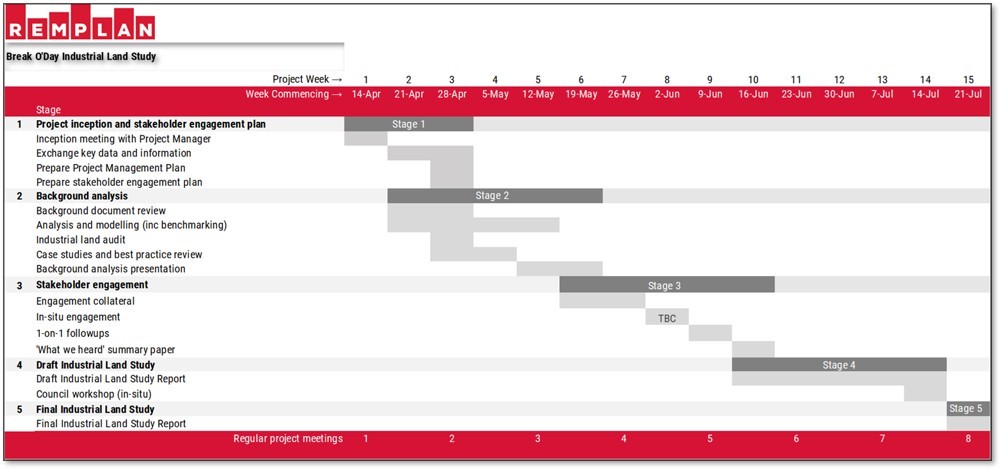
How can I get involved?
Stakeholder engagement is an important part of this project and as the engagement strategy is finalised, more information will become available on this page as well as other communication channels. REMPLAN have access to an extensive stakeholder database and so further information will be coming soon.
At this stage it is likely that the final report will be delivered in July 2025 and publicly available soon after.
*Timelines are subject to change based on how each stage of the project progresses.
For more information:
Contact Council on telephone 6376 7900 or email admin@bodc.tas.gov.au.
You can find a list of Upcoming Works activities here:




